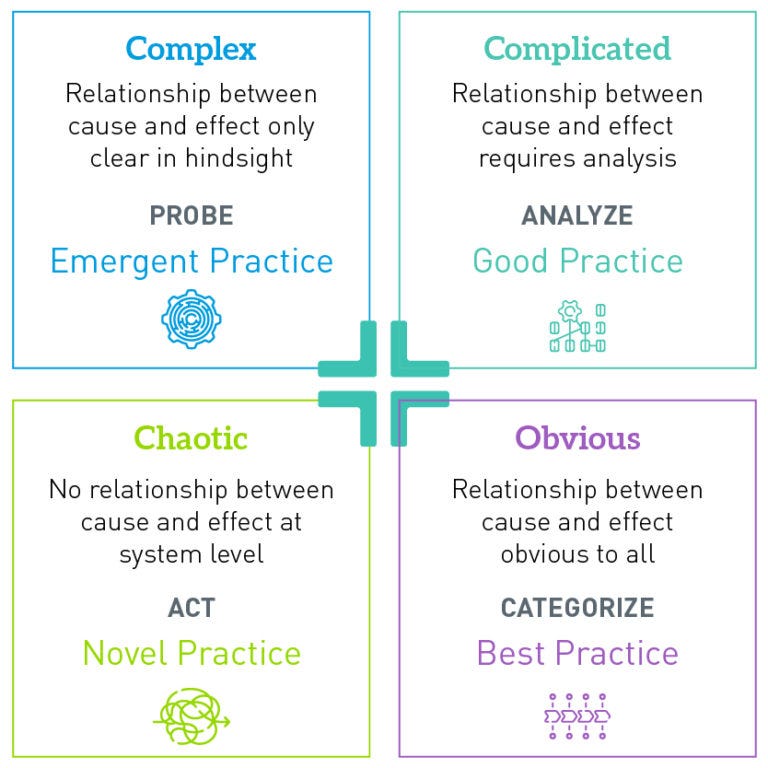Discomfort vs. Uncomfortable
We say we need to leave out comfort zones to grow, but how far outside of them do we really need to go to benefit?
We’ve all heard that you need to leave your comfort zone in order to grow. In fact, just last week this very newsletter advocated for this method to gain some perspective when it comes to the day-to-day harriedness of many of our lives. While there’s nothing inherently wrong with comfort zones, if we take our eye off the ball it’s all too easy to stagnate within them.
But there’s a second swing to this pendulum. Often in management, we use this excuse of comfort zones as a cover to throw someone into a situation they may not be ready for with minimal (or no) guidance. “They’re bright, they’ll figure it out,” we tell ourselves, as we make their foray into a new challenge much harder than it needs to be.
Ambiguity in the Comfort Zone
But is this the best use of their time? How much growth is going to occur if half the time that employee is simply trying to figure out a process or an end goal that was not clearly laid out for a stretch project? The skillset of untying a knot of instructions that lack clarity may be necessary in a chaotic organization, but it isn’t very useful in a high-functioning organization.
And therein lies one of the pitfalls: many job descriptions throw the line out “comfortable with ambiguity.” This, dear reader, is a red flag. One of the great skills of a leader is clarity. Clarity in the purpose and mission of a company. Clarity in a team’s goals and ways of working. And clarity in project goals and process.
If a company is saying they regularly provide an employee with ambiguous tasks, management is essentially ceding the responsibility of clarity and putting it on the junior rank and file. And this is not when pressed on clarity of role - they’re proactively saying “We’re not sure of the business objective and we’re going to go ahead and dump that onto you, so get ready.”
Captain Obvious
“But Matt, you ignorant slut,” you say. “Business is ambiguous by nature - if everything were clear it would be easy.” And this is true - there are multiple ways to tackle a problem and multiple strategies to accomplish a large-scale project’s objectives. But we often interchangeably use “ambiguous” when we really mean “complex.”

There is a small subset of business challenges that will fit the ambiguous mold - these reside in the “Chaos” portion of the above chart. No one should be comfortable here and even though our world continues to get more and more complex, it’s a leader’s job to keep their organization and team out of the bottom left corner and in safer waters.
The “Complex” portion won’t have obvious pathways to success, but the objectives should be clear, as should the experiments to move it over into “Complicated” via solid process documentation. If an organization’s modus operandi resides in the lower-left corner, its best employees will burn out very quickly - time needs to be spent in the “Obvious” and “Complicated” areas to recharge.
Comfort Zone Defense
And this brings us back to comfort zones - sticking with the Cynefin Framework, the right side of the chart is comfortable for us. The solution is either obvious or has documented solutions. The left side of the chart is uncomfortable, but there are important distinctions here.
The growth area of discomfort is in the “Complex” portion - these are difficult problems, but they’re not impossible. And with the right guidance and clear goals from their manager, junior employees who are looking to grow will thrive here. This isn’t a wildly uncomfortable place to be, but there is discomfort (which is where the growth comes from.)
The “Chaos” portion of the framework should not be a regular occurrence at work, and certainly not for junior employees. The goal of approaching a problem that falls under chaos is not to solve it, but to move it into a place where it is more complex than chaotic. This is very much an uncomfortable place to be and any growth opportunities will be limited by the “hair on fire” pace of getting out of the chaos bucket.
Accountability
This is where clarity is so important - if you simply throw a junior employee into a complex task without clear expectations, they will likely fail. And too often managers point to this failure as the fault of the junior, when in reality they were not given the opportunity to succeed from the start.
The accountability game should be a top-down exercise, not the other way around. When a junior employee fails at something, their manager should be asking themselves if they contributed to that failure, or if the junior was given all of the tools they needed to succeed and still came up short. Rarely does a failure at work fall solely on a single person - it’s typically a multi-touch attribution of why something failed. Managers are all too quick to point to a junior employee; leaders differentiate themselves by trying to figure out where it really went wrong across the entire chain of command.
So the “sink or swim” or “baptism by fire” method of having your junior employees grow can backfire by creating an environment so uncomfortable as to hinder the very growth you’re trying to catalyze. Try to find that sweet spot where the problems are complex, but the goals are clear and the support is readily available. The goal is tolerable discomfort, not the state of being uncomfortable.
Grab Bag Sections
WTF Putin: Space nukes? Space nukes?!? If you had written a movie and made the villain an ex-spy who, in a transparent bid to take away from his losing a war of his starting, deployed nuclear weapons in space in a mutually-assured destruction play like this, the studios would tell you to tone it down because it simply wouldn’t be believable.
They would also object to the plot line of the opposition party of a major worldpower leaking the news in order to…welll…no one’s quite really sure, but they would tell the writers to revise that portion because the audience wouldn’t stand for their elected officials doing something so stupid.
Yet, here we are.
Album of the Week: Someone named after Rakim needs to deliver if they’re going to put out a rap album. And A$AP Rocky certainly did that with his debut studio album.
Long. Live. A$AP. was the result of a nice little bidding war between labels, and given the deal structure Rocky got from RCA the bank account braggadocio is pretty on-point. He was just getting famous, and for those who had a radio in the winter of 2012, “Fuckin’ Problems” was inescapable (probably why it went 8x platinum in the US.) The story of the song being passed back and forth between Drake, Kendrick, back to Drake, and finally to A$AP is interesting, as is the co-production credit to one C. Papi.
Another ensemble track in “1 Train” is absolute fire, minus an ill-adivsed feature from Yelawulf. The outro in “Suddenly” begins Rocky’s knack for ending albums on high notes. You can skip “Wild for the Night.” It falls into the category of rappers trying to force an EDM crossover and it not really working. A very solid debut album from A$AP Rocky.
Quote of the Week: “We enjoy the comfort of opinion without the discomfort of thought.” - JFK
See you next week!








